-
CENTRES
Progammes & Centres
Location
New Delhi is aware that Pakistan’s military establishment will continue its proxy war, nonetheless, it favours a ceasefire for as long as possible without compromising its security

The third anniversary of the ceasefire understanding between India and Pakistan was marked on 25 February. The ceasefire stands intact amidst immensely fraught ties between the two countries following the Pulwama terror attack in February 2019 and the abrogation of Jammu and Kashmir’s ‘special status’ on 5 August 2019. Despite Pakistan’s reluctance to accept the constitutional changes in J&K and no thaw in relations, there has been considerable peace on the border after the Director Generals of Military Operations (DGsMO) understanding on a ceasefire in February 2021.
The ongoing status quo has benefited both India and Pakistan, particularly the border population along the International Border (IB) and Line of Control (LoC). With almost non-existent diplomatic engagement between India and Pakistan, any semblance of peace on the border should be welcomed. Nonetheless, the silence on the border does not imply that Pakistan has stopped cross-border terror activities against India or that there is no risk of escalation between the two militaries in the future. The ceasefire has helped manage the India-Pakistan conflict, but it has not altered the dynamics of the overall peace process, or the lack thereof, in the last three years.
With a new coalition government in Islamabad and Pakistan Army Chief General Syed Asim Munir’s persistently hawkish views on India, bilateral ties may not see any forward movement. However, both countries may continue to keep the ceasefire intact to focus on other urgent issues.
Agreeing to a ceasefire after years of violence on the border was a significant achievement for both India and Pakistan. It saved the lives of many civilians and security personnel on both sides. Furthermore, with peace on the western front, New Delhi could focus more on the Line of Actual Control (LAC) standoff with China. For Islamabad, the ceasefire brought relief to its dwindling economy and allowed Pakistan’s military establishment to address political and security crises within the country. A year prior to the ceasefire, there were close to 5,133 incidents of Ceasefire Violations (CFVs) in 2020, the highest since 2003. However, the numbers declined to roughly 670 in 2021, most occurring before the two DGsMO discussions in February.
Furthermore, there has been a noticeable improvement in the overall security situation in J&K since August 2019 and the border ceasefire in 2021. The current government has implemented a ‘zero-tolerance policy’ against terrorism in the region. This policy involves both central and local security agencies working in tandem to target not only terrorists but also their financial and overground networks in J&K. Consequently, schools, colleges, and local businesses in the Kashmir Valley are now functioning more normally than they were a few years ago.
However, does this improvement in J&K’s security scenario and the border ceasefire suggest any change in Pakistan’s decades-long policy of aiding and abetting terrorism in India? The simple answer is no.
Notwithstanding the ongoing pause in border confrontations between the two militaries, Pakistan continues its proxy war against India. Terror groups like the People’s Anti-Fascist Front (PAFF) and The Resistance Front (TRF), which are proxy fronts for Pakistan-based organisations Jaish-e-Mohammad (JeM) and Lashkar-e-Tayyaba (LeT), have targeted Indian security forces and civilians in J&K. In 2022, the total number of terror-related incidents recorded was 125, compared to 46 in 2023. Meanwhile, the Union Territory witnessed 31 targeted killings of civilians, mostly Hindu minorities and non-locals, by terrorists in 2022, and a total of 14 in 2023. More importantly, the Rajouri-Poonch sector in south of the Pir Panjal range is experiencing a resurgence in militancy after years of relative peace in the region, which is an “issue of concern”, according to Indian Army Chief General Manoj Pande.
To address the resurging militancy in the region, the Indian Army launched an anti-terror Operation Sarvashakti in January, similar to Operation Sarp Vinash of 2003. The objective is to eliminate terrorists and local overground workers (OGWs) involved in a series of ambushes targeting Indian troops in the Rajouri-Poonch sector. These attacks have primarily occurred near the Line of Control (LoC), indicating infiltrations from the Pakistani side. Unfortunately, this tactic has resulted in casualties on the Indian side, as terrorists can seek refuge in nearby dense forests or caves after attacking Indian security forces personnel. It is estimated that over 20 Indian Army personnel have lost their lives in these ambushes in the last three years. As the Kashmir zone has become quieter since August 2019, there is a deliberate attempt to shift the proxy war to the border districts of J&K. This increases the risk of jeopardising the border ceasefire.
Although cross-border terror activities from Pakistan have remained a significant factor behind the border violence between the two countries, the substantial increase in illegal drone activities has presented a new dimension of a security threat to India. These drones are primarily used for surveillance and smuggling drugs, weapons, money, and other illicit materials into different sectors of the IB and LoC on the Indian side.
The drone ‘menace’ has raised serious concerns within India’s security establishment, particularly following the twin drone-driven blasts at the Indian Air Force’s technical station in Jammu on 27 June 2021, with suspected cross-border links. According to reports, India’s Border Security Force (BSF) seized or shot down 119 drones in 2023 along the western sectors, with another 400-500 sightings reported.
While there is currently no direct evidence linking drone intrusions to incidents of ceasefire violations on the IB or LoC, there is a possibility that it could contribute to future border tensions between the two countries.
It is widely known that General (Retd) Qamar Javed Bajwa, Pakistan’s former army chief, wanted to improve ties with India, at least temporarily. According to some Pakistani journalists, Bajwa sought to “freeze” the Kashmir issue for at least 20 years because the “Pakistan army was not capable of going to war with India.” That proposal did not materialise due to reported disagreements between Bajwa and the then Imran Khan government.
Nevertheless, Pakistan agreed to at least recommit to the 2003 ceasefire understanding during Bajwa’s tenure, which remains intact under the present army leadership of General Syed Asim Munir. But, does the 2021 ceasefire understanding suggest a change of heart in Pakistan’s security establishment regarding India? Perhaps, the answer lies in the double-digit inflation, looming default threat, and internal political and security crises in Pakistan. Moreover, while Bajwa was publicly claiming to improve relations with India, Munir has openly ruled out reconciliation with India. It is possible that Munir’s previous roles as Director General of Military Intelligence (MI) and Director General Inter-Services Intelligence (ISI) sharpened his views on India. Notably, he was DG ISI during the Pulwama terror attack and subsequent Balakot military crisis in February 2019.
This is Munir’s second year-in-progress as Pakistan’s army chief. With a new (selected) government in Islamabad following an allegedly rigged election, Munir is in a stronger position to influence both domestic and foreign policy matters in Pakistan, including on India. Given Pakistan’s dire economic situation and tensions on its western front with Afghanistan and Iran, would Munir risk breaking the current status quo with India and further destabilise Pakistan?
Making a prediction at this point is challenging. However, considering Munir’s focus on revitalizing Pakistan’s struggling economy through initiatives like the Special Investment Facilitation Council (SIFC), which is his pet project, he may avoid escalating tensions with India beyond a certain threshold. After all, no foreign investors would be eager to invest in a destabilised Pakistan.
In conclusion, New Delhi is aware that Pakistan’s military establishment will continue its proxy war against India, employing both old and new tactics. Nonetheless, India favours a border ceasefire for as long as possible without compromising its security. Additionally, it would be prudent for India to have a stable western front to develop adequate border and military infrastructure along the LAC to deter China. Managing two active border fronts can put added pressure on the Indian armed forces. On the other hand, faced with a looming default crisis and internal security issues, Pakistan cannot afford to handle three active fronts—with Afghanistan and Iran to the west and India to the east.
Sarral Sharma is a Doctoral Candidate at Jawaharlal Nehru University, New Delhi.
The views expressed above belong to the author(s). ORF research and analyses now available on Telegram! Click here to access our curated content — blogs, longforms and interviews.

Sarral Sharma is a Doctoral Candidate at Jawaharlal Nehru University New Delhi. He has previously served in the National Security Council Secretariat. He was a ...
Read More +